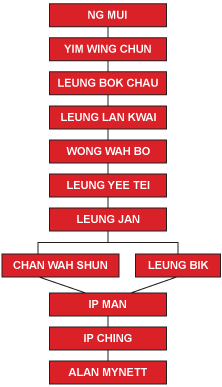Wing Chun Family Tree


The founder of Wing Chun Kung fu system, Miss Yim Wing Chun was a native of Guangdong, China. As a young girl, she was intelligent and athletic, upstanding and manly. She
was betrothed to Leung Bok Chau, a salt merchant of Fukien. Soon after that, her mother died. Her father, Yim Yee was wrongfully accused of a crime and nearly went to jail. So the family moved far away and finally settled down at the foot of Tai Leung Mountain at the Yunnan-Szechuan border. All this happened during the reign of Emperor K'anghsi (1662-1722).
was betrothed to Leung Bok Chau, a salt merchant of Fukien. Soon after that, her mother died. Her father, Yim Yee was wrongfully accused of a crime and nearly went to jail. So the family moved far away and finally settled down at the foot of Tai Leung Mountain at the Yunnan-Szechuan border. All this happened during the reign of Emperor K'anghsi (1662-1722).
At the time Kung fu was becoming very strong in Siu Lam Monastery (Shaolin Monastery) of Mt. Sung, Honan. This aroused the fear of the Manchu government which sent troops to attack the Monastery. They set fire to the Monastery while soldiers attacked. Siu Lam was burnt down and the monks scattered. Buddhist Abbess Ng Mui, Abbot Chi Shin, Abbott Pak Mei, Master Fung To Tak and Master Mui Hinescaped and fled their seperate ways.
Ng Mui took refuge in White Crane Temple on Mt. Tai Leung (also known as Mt. Chai Har). There she came to know Yim Yee and his daughter Yim Wing Chun. She bought bean curds at their store and they became friends. Wing Chun was a young woman then and her beauty attracted the attention of a local bully, he tried to force Wing Chun to marry him, she and her father were very worried. Ng Mui learned of this and took pity on Wing Chun. She agreed to teach Wing Chun fighting techniques so that she could protect herself and she would then be able to solve the problem with the bully and marry Leung Bok Chau, her betrothed husband. Wing Chun followed Ng Mui into the Mountains and started to learn Kung fu. She trained night and day and mastered the techniques. Then she challenged the local bully to a fight and beat him. Ng Mui set off to travel around the country but before she left she told Wing Chun to strictly honour the Kung fu traditions, to develop her Kung fu. This is how Wing Chun Kung fu was handed down by Abbess Ng Mui.
After the marriage, Wing Chun taught her Kung fu to her Husband Leung Bok Chau and he passed his Kung fu techniques on to Leung Lan Kwai. Leung Lan Kwai passed it on toWong Wah Bo. Wong Wah Bo was a member of an opera troupe on board a Junk, known to the Chinese as the Red Junk. Wong worked on the Red Junk with Leung Yee Tei. It also happened that Abbot Chi Shin who fled from Siu Lam had disguised himself as a cook and was now working on the Red Junk. Chi Shin taught the Six-and-a-half Point Long Pole Techniques to Leung Yee Tei. Wong Wah Bo was close to Leung Yee Tei and they
shared what they knew about Kung fu. Together they correlated and improved their techniques and thus the Six-and-a-half Point Long Pole Techniques were incorporated
into Wing Chun Kung fu.
shared what they knew about Kung fu. Together they correlated and improved their techniques and thus the Six-and-a-half Point Long Pole Techniques were incorporated
into Wing Chun Kung fu.
Leung Yee Tei passed the Kung fu on to Leung Jan, a well known herbal doctor in Foshan. Leung Jan grasped the inner most secrets of Wing Chun and attained the highest level of proficiency. Many Kung fu Masters came to challenge him but all were defeated. Leung Jan became very famous. Later, he passed his Kung fu on to his student Chan Wah Shun and his two sons, Leung Bik and Leung Cheun.
Chan Wah Shun and Leung Bik passed their Kung fu on to Grandmaster Ip Man. Grandmaster Ip Man was the first to teach Wing Chun openly to the public. He taught a few people in Foshan, China and of course his students in Hong Kong, including his two sons Grandmaster Ip Chun and Grandmaster Ip Ching who both now teach in Hong Kong.

